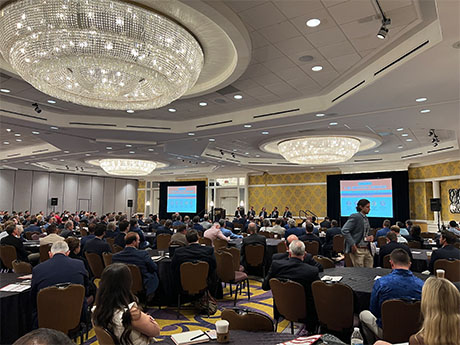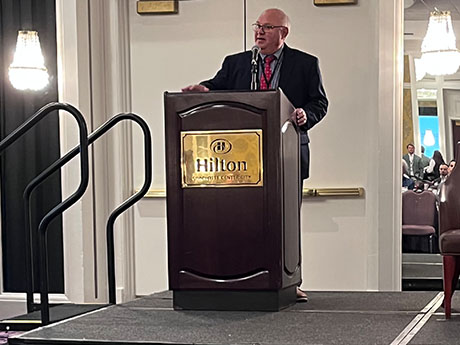Interstate 85 traverses through the heart of the Southeast, the fastest-growing region in the United States by way of population. The southern terminus of the 666-mile interstate is in Montgomery, Ala., home of the mega Hyundai Motor Manufacturing Alabama plant, and it travels north to just shy of Richmond, Va., the site of North America’s first LEGO factory.
Along the way, I-85 connects through Atlanta and the Carolinas markets of Greenville-Spartanburg, Charlotte, Greensboro and Raleigh-Durham. These I-85 Corridor markets have seen their fair share of industrial development in recent years, so much so that for the first time this cycle, some experts are worried about overbuilding.
Steven McGee, vice president of Southeast development at Rockefeller Group, said that half of the nation’s population growth has been coming to the Southeast region, and that faucet isn’t expected to be shut off anytime soon.
“America is getting bigger, and half of that growth is occurring in three or four states,” said McGee. “I don’t see any real structural elements that are stopping that growth. It’s a challenge on the timing [for industrial deliveries], but in almost every market we have record vacancy. We have very few options for occupiers coming into the market to take big blocks of space.”
McGee’s comments came during the opening panel about development trends at InterFace I-85 Industrial Corridor, a networking and information conference that took place on Wednesday, May 24 at the Hilton Charlotte Uptown hotel. The event was hosted by InterFace Conference Group and Southeast Real Estate Business. Kyle Holbrook, associate vice president at FCL Builders, moderated the discussion.

The panelists do not believe that the I-85 markets are overbuilt on the whole but do allow that the timing of the recent wave of industrial deliveries may take a touch longer to be absorbed by the market than previous years.
“In probably every market on the I-85 corridor, especially the markets that I cover — Charlotte, Greenville and Atlanta — we are seeing record amounts of new construction, both in the number of buildings and by square footage. And only a small amount is preleased,” said Drew Nations, development manager at Panattoni Development Co. “But thematically and on a long enough timeline, no I don’t think we’re overbuilt.”
“If you look at all these millions of square feet of development and boil it down to size segments and to submarkets, we’re even seeing that certain size ranges are undersupplied,” added Jordan Quinn, partner of Trinity Capital Advisors’ industrial real estate platform.
Quinn said that for the 1 million-square-foot and larger distributions that were built on speculative bases over the past several years — which the panelists referred to as “big bombers” — there is some softness. Quinn joked that as a result, brokers now have to do something that they haven’t had to do in years.
“Brokers are going to have to actually show space again, and tenants are going to have to tour the inside of the buildings before they sign a lease,” said Quinn.
Because of shifting market preferences, the panelists agreed that the industrial segment that was needed most in every market was smaller, flexible buildings that fall in the 50,000- to 200,000-square-foot range.
“As one of the guys up here with a big bomber that is basically done, if you could have a couple 200,000-square-foot buildings, I think you’d be a pretty happy person,” said Justin Curis, vice president of industrial development at The Keith Corp. “There is not a lot of product available that’s considered Class A where you can split it to 50,000 feet. It’s slim pickings for that product, so that’d be a great product to have.”
In addition to product type and size, the development panel also discussed site selection trends in the I-85 Corridor. Quinn said that a couple years ago, developers were targeting building infill developments or within 20 miles of center city, but now that is being stretched 60 to 70 miles in some markets, which is causing the boundaries of some of the I-85 markets to essentially overlap.
The developers cited the COVID-19 pandemic a couple times as accelerating development trends that had already been in place.
“We’re at a moment in time where so much growth has happened, and now developers are starting to understand where tenants want to be,” said Quinn. “Building to the market is going to be important.”
Nations said that it’s a fine art and an almost philosophical balance for developers to either pick sites in established submarkets where there will be “five turns” off the interstate, or to choose a new exit off the interstate to activate.
“Workforces in a lot these instances are commuting into these markets, so we can put buildings closer to them,” said Nations.
Macroeconomic challenges
Overbuilding may not even be a top five worry for industrial developers at the moment.
For one, debt capital is a lot more expensive at this point in the cycle than even 12 months ago. In that time, the Secured Overnight Financing Rate (SOFR), a short-term interest rate that construction lenders often use in underwriting, has jumped from 0.78 percent to 5.06 percent, a more than 400-basis-point swing.
“These interest rate spikes have really hit a lot of developers’ reserves for these spec buildings,” said Curis. “It’s hard when you pro-forma a spec building with a 3 percent [all-in] interest rate and that’s now trending up toward 8 percent at the end of the cycle. It’s a quick way to deplete your capital.”

Curis and the other panelists mentioned that developers now have to take on additional equity partners to float new construction.
The Federal Reserve has been rapidly raising interest rates in an effort to curb inflation.
At its May meeting, the Federal Open Markets Committee raised the federal funds rate to a target range of 5 percent to 5.25 percent. The fed funds rate is the interest rate that U.S. banks charge each other to lend funds overnight. This time a year ago, the short-term benchmark rate was at a range of 0.75 percent to 1 percent.
Mark Vitner, chief economist at Piedmont Crescent Capital, gave a keynote address at the InterFace I-85 Industrial Corridor event. Unfortunately for developers and investors alike, Vitner said that inflation is proving “sticky,” thus interest rates aren’t likely to come down anytime soon.
“There is a growing realization that the Fed is more likely to raise interest rates in June than to leave them unchanged,” said Vitner, who was formerly a chief economist at Wells Fargo. “A majority of the Federal Reserve speakers for the past two weeks have said the Fed is more inclined to raise rates.”
Vitner did add that it’s not a guarantee that raise rates will rise because the Federal Reserve will be receiving the results from its supervisory stress tests of the banks it monitors shortly before the June FOMC meeting, which could sway the central bank to leave the rates alone.
The chief economist began his discussion theorizing that the U.S. economy will likely enter a recession in the second half of this year. And even if this comes to fruition, Vitner doesn’t believe the Federal Reserve will be in a position to cut rates.
“A lot of economists will tell you that the Fed will cut rates as soon as employment starts falling, but the problem with that logic is that employment data are recorded with a lag during the early returns — and they get revised,” said Vitner. “I don’t think we’ll see these job losses anytime soon, so I think rates are going to be higher for longer.”
Vitner also added that even once the Federal Reserve cuts rates, the days of seeing nearly zero interest rates are gone.
— John Nelson


